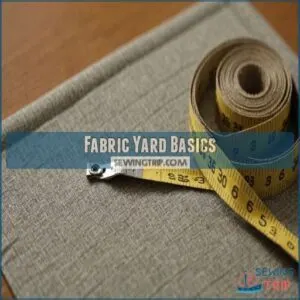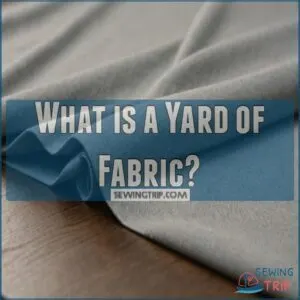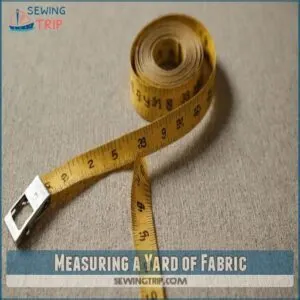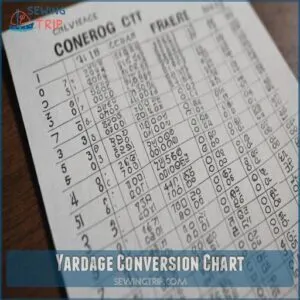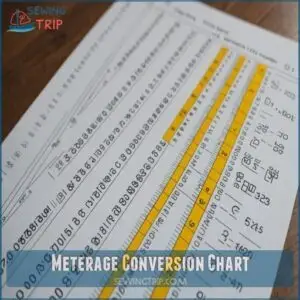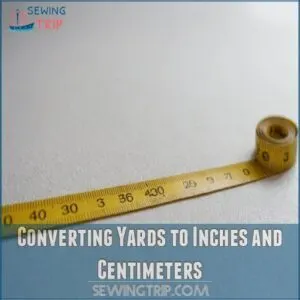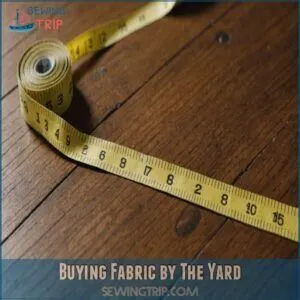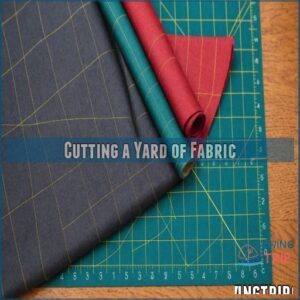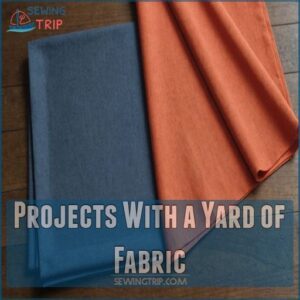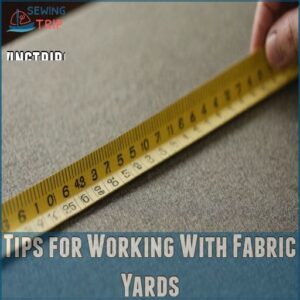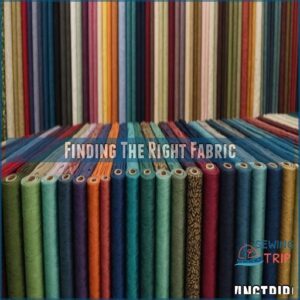This site is supported by our readers. We may earn a commission, at no cost to you, if you purchase through links.
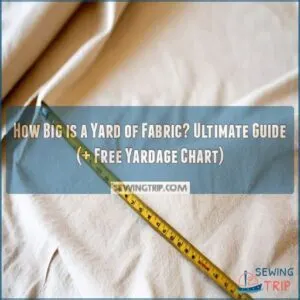
It’s like three rulers laid end-to-end or the length of your arm stretched out (if you’re tall).
The width can vary, typically ranging from 36 to 60 inches.
Think of it as a rectangle: 1 yard long, but potentially wider than it is long.
You’ll often hear sewers talking about "running yards," which refers to this length-wise measurement.
Remember, fabric stores usually cut a bit extra to account for shrinkage and uneven edges.
Knowing these dimensions is important for your projects, but there’s more to fabric shopping than just numbers.
Fabric types and patterns can greatly impact your yardage needs.
Table Of Contents
- Key Takeaways
- Fabric Yard Basics
- What is a Yard of Fabric?
- Measuring a Yard of Fabric
- Fabric Width and Yardage
- Fabric Yardage Conversion
- Buying Fabric by The Yard
- Cutting a Yard of Fabric
- Projects With a Yard of Fabric
- Tips for Working With Fabric Yards
- Finding The Right Fabric
- Frequently Asked Questions (FAQs)
- Conclusion
Key Takeaways
- You’ll always get a yard of fabric that’s 36 inches long, but the width can vary significantly, typically between 36 and 60 inches, affecting your project plans.
- Buying wider fabric is more economical as it reduces waste and gives you more material to work with for your sewing needs.
- Pre-wash your fabric to prevent shrinkage surprises, especially with natural fibers like cotton, ensuring accurate size after cutting.
- Always purchase a bit of extra fabric for pattern matching, potential shrinkage, and cutting errors to safeguard your project completion.
Fabric Yard Basics
You’ll find that a yard of fabric is 36 inches long.
Fabric width can vary from 36 to 60 inches.
Understanding these basics will help you measure and buy fabric more effectively for your sewing projects.
Standard Length and Width
Regarding fabric dimensions, you’re looking at a standard length of 36 inches for a yard.
But here’s where it gets interesting: fabric width can vary.
You’ll typically find widths ranging from 36 to 60 inches.
This variation in width affects your yardage calculations, so keep it in mind when planning projects.
Understanding these standard dimensions gives you more control over your fabric choices and helps you avoid surprises at the cutting table.
Measuring Fabric Yards
You’ve got the standard length down, now let’s tackle measuring fabric yards by understanding that a standard yard of fabric is 36 inches or 3 feet long, as seen in fabric measurements basics. You’ve got the standard length down, now let’s tackle measuring fabric yards.
Grab your trusty measuring tape or yardstick – they’re your new best friends.
Lay your fabric flat on a table, smoothing out any wrinkles.
Starting at one end, measure 36 inches along the selvage edge.
That’s your yard!
For wider fabrics, you’ll get more bang for your buck.
Remember, accurate measurements are key to avoiding fabric waste and nailing your sewing projects.
Converting Yards to Meters
For international fabric sizing, it’s important to master meter-yard conversion.
One yard equals about 0.9144 meters, or roughly 91 centimeters.
When working with different fabric widths, keep in mind that a yard of fabric contains approximately 3,960 square inches, which is important for calculating fabric yardage.
To convert yards to meters, multiply by 0.9144.
For a quick estimate, remember that a yard is slightly shorter than a meter.
This knowledge is handy when calculating fabric needs or using a meterage conversion chart.
Keep a fabric yardage conversion tool nearby for precise measurements.
What is a Yard of Fabric?
You’ll find a yard of fabric is always 36 inches long, but its width can vary from 36 to 60 inches or more.
Think of it as a long strip of material that’s as tall as a first-grader, with enough fabric to wrap around you like a blanket or create several fun projects.
Typical Dimensions
A yard of fabric is like a magic carpet ready for your sewing adventures. It’s always 36 inches long, but the width can vary. Picture a blanket stretched out before you – that’s your yard of fabric. The width typically ranges from 36 to 60 inches, giving you plenty of room to play.
- Excitement: Imagine all the possibilities with a fresh yard of fabric!
- Curiosity: What’ll you create with this blank canvas?
- Anticipation: Your next project is just a cut away.
- Satisfaction: Knowing exact dimensions puts you in control.
Square Footage
A yard of fabric’s square footage varies based on its width.
For 36-inch wide fabric, you’ve got 9 square feet to work with.
If it’s 45 inches wide, that jumps to 11.25 square feet.
Got 54-inch fabric? You’re looking at 13.5 square feet.
You can find a wide variety of fabrics in different widths by buying fabric yard.
Wider fabrics give you more bang for your buck, reducing waste and maximizing your project potential.
Use a fabric calculator to estimate your needs accurately.
Running Yard of Fabric
A running yard of fabric is a continuous length measured from one end to the other, spanning 36 inches or 3 feet.
It’s like rolling out a carpet runner, but with fabric.
The width can vary, typically ranging from 36 to 60 inches.
Remember, when you’re buying fabric, you’re getting a strip that’s 36 inches long, no matter how wide it is.
This standardized length makes fabric shopping a breeze!
Measuring a Yard of Fabric
To ensure accuracy in your sewing projects, it’s crucial to understand the basics of sewing, including choosing the right fabric type. You’ll need to know how to measure a yard of fabric accurately for your sewing projects.
Let’s explore some practical methods to measure fabric yardage, from using a simple yardstick to calculating square footage for specific projects.
Using a Yardstick
Grab your trusty yardstick and let’s measure fabric like pros!
Place it along the selvage edge, keeping the fabric tension even.
Remember, a yard’s exactly 36 inches or 3 feet.
Don’t include the selvage in your measurement to avoid yardage mistakes.
For wider fabrics, measure across too.
When fabric shopping, this skill’s a game-changer.
You’ll breeze through fabric stores, knowing precisely how much you need for your next masterpiece.
Calculating Square Footage
Let’s crunch some numbers to figure out your fabric’s square footage. The width of your fabric plays a big role here.
A 36-inch wide yard gives you 9 square feet, while a 45-inch width bumps it up to 11.25 square feet.
To get the most accurate measurements, consider using a fabric yardage calculator online.
Got 54-inch wide fabric? That’s 13.5 square feet. For quilting fabric at 60 inches, you’re looking at a generous 15 square feet per yard.
Knowing these numbers helps you avoid fabric waste and nail your pattern placement.
Measuring for Specific Projects
When measuring for specific projects, you’ll need to factor in more than just a yard of fabric.
Your project requirements dictate your fabric needs.
Here’s what to keep in mind:
- Pattern yardage: Follow the pattern’s recommendations closely
- Cushion coverage: One yard typically covers two 16×16 inch cushions
- Dressmaking projects: Account for body measurements and design details
Remember, fabric shrinkage can throw off your calculations.
Always pre-wash your fabric and add a bit extra to be safe.
Happy sewing!
Fabric Width and Yardage
Fabric width plays a key role in determining how much yardage you’ll need for your project.
While a yard of fabric is always 36 inches long, the width can vary from 36 to 60 inches, affecting both the amount of material you get and its cost-effectiveness.
Wider Fabric is More Economical
Now that you’ve got the hang of measuring fabric, let’s talk savings.
Wider fabric is your wallet’s best friend.
With more room to play, you can place patterns like puzzle pieces, cutting down on waste.
It’s like getting more bang for your buck – the cost per square foot often drops as width increases.
So, next time you’re eyeing fabric deals, remember: wider rolls could mean bigger savings for your project.
Narrower Fabrics and Waste
Narrower fabrics can be a real headache for your sewing projects. They often lead to more waste and mightn’t fit your pattern pieces as efficiently.
Here’s what you need to know:
- You’ll likely need more yardage for the same project
- Pattern layout becomes trickier, requiring creative solutions
- Selvage edges eat up more usable width
- Matching prints or stripes gets more challenging
- Pre-cutting precautions are essential to avoid mistakes
Don’t let narrow fabric cramp your style – plan ahead and you’ll breeze through your project!
Varying Fabric Widths
Fabric widths can be as varied as your wardrobe choices. You’ll find loom widths ranging from 36 to 60 inches, with specialty fabrics like silks and embroidered pieces often narrower.
Understanding yard of fabric measurements can help you determine how much yardage you’ll need for projects.
This variety affects how much yardage you’ll need for projects. Wider fabrics usually mean less waste and more bang for your buck.
Remember, a yard of fabric’s width can make or break your seasonal sewing plans, whether it’s breezy summer dresses or cozy Christmas quilts.
Fabric Yardage Conversion
You’ll find fabric yardage conversion handy when switching between measurement systems.
A yard equals 36 inches or about 91 centimeters, making it easy to calculate how much fabric you need for your projects.
Yardage Conversion Chart
Ever felt lost in the fabric conversion maze?
You’re not alone.
A yardage conversion chart is your trusty map for understanding fabric dimensions, especially when trying to calculate yardage for various fabric widths like quilting cotton and home decor fabrics, which can range from common fabric widths for different projects. A yardage conversion chart is your trusty map for understanding fabric dimensions.
It’s a lifesaver when you’re juggling yards, inches, and centimeters.
Here’s why you’ll love it:
- Quick conversions at a glance
- Saves time on complex calculations
- Helps avoid costly measurement mistakes
This handy tool lets you breeze through fabric shopping and project planning.
No more second-guessing your yardage needs – just check the chart and cut with confidence!
Meterage Conversion Chart
Converting between meters and yards can be a breeze with a meterage conversion chart.
You’ll find it handy when shopping for fabric online or at stores like Hobby Lobby or Joann’s.
A meter is slightly longer than a yard, so 1 meter equals about 1.09 yards.
Keep this chart in your sewing dictionary for quick reference.
It’ll save you time and prevent measurement mishaps in your crafting adventures.
Converting Yards to Inches and Centimeters
You’ve got the meterage chart down, now let’s tackle yards to inches and centimeters.
It’s a breeze once you know the basics.
One yard equals 36 inches or about 91 centimeters.
Here’s a quick breakdown to help you master fabric yardage conversion:
- Multiply yards by 36 for inches
- Multiply yards by 91.44 for centimeters
- Divide inches by 2.54 for centimeters
Keep these conversions handy in your sewing library for smooth sailing through your projects!
Buying Fabric by The Yard
When you’re buying fabric by the yard, it’s important to know that most stores sell in full yards with minimum cuts of 1/4 yard.
You’ll want to check the fabric width and consider purchasing a little extra to make sure you have enough for your project.
Minimum Cuts and Full Yards
Most fabric stores have specific policies on minimum cuts.
You’ll typically find that the smallest cut is 1/4 yard, but some places might go as low as 1/8 yard.
Here’s a quick guide to common minimum cuts and their uses:
| Cut Size | Length (inches) | Typical Uses |
|---|---|---|
| 1/8 yard | 4.5 | Small crafts |
| 1/4 yard | 9 | Quilting |
| 1/2 yard | 18 | Accessories |
Remember, buying full yards can often save you money in the long run, especially for larger projects.
Checking Fabric Width
Before you buy, always check the fabric width.
Different fabrics come in various widths due to different loom sizes.
Quilting cotton might be 44" wide, while upholstery fabric could be 54" or more.
Use a measuring tape to confirm the width at the store.
Remember, fabric width affects how much you’ll need for your project.
Wider fabrics often mean less waste and more bang for your buck.
Purchasing Extra Fabric
When buying fabric, it’s smart to purchase a bit extra.
This safeguards you against potential mishaps and makes sure you have enough for your project.
Here’s why getting some extra yardage is a good idea:
- Allows for fabric shrinkage after washing
- Provides room for pattern matching on prints or stripes
- Covers unexpected cutting errors or complex project needs
- Enables you to take advantage of bulk discounts, potentially saving money
Remember, a little extra fabric beats the frustration of coming up short!
Cutting a Yard of Fabric
You’re ready to cut your fabric, but hold on!
Before you grab those scissors, make sure you’ve removed the selvage.
You’ll also want to square up your fabric, and use sharp tools for clean cuts.
Removing Selvage and Squaring Up
Now that you’ve got your fabric, let’s get it ready for cutting.
The selvage edges (those tightly woven strips along the sides) need to go – they’ll only mess with your project’s drape.
Pull your fabric taut and align it with your cutting surface’s grid lines to square it up.
You’ll notice the fabric grain running straight as an arrow once it’s properly aligned.
Using Sharp Scissors and Rotary Cutters
A sharp blade makes all the difference between perfect cuts and frustrating fabric mishaps.
You’ll find that rotary cutters glide through fabric like butter, while quality fabric scissors give you precise control for detailed work.
Here’s what you need for clean, professional cuts:
- Keep your blades razor-sharp with regular maintenance
- Use a self-healing cutting mat to protect surfaces
- Replace dull rotary blades regularly
- Store scissors in protective cases between uses
Pre-Shrinking Fabric
Sharp tools set you up for success, but your fabric needs proper prep too.
When purchasing fabric by the yard, you need to think about the width and material, such as those found in various fabric per yard products.
Here’s a game-changer: pre-washing prevents those frustrating size surprises later.
Natural fibers like cotton can shrink up to 10% in the wash, so toss your fabric in the washing machine before cutting.
You’ll want to use warm water and dry according to the fabric type – just like you’d treat the finished garment.
Projects With a Yard of Fabric
You’ll be amazed at how many projects you can create with just one yard of fabric, from stylish wallets and aprons to cozy pillowcases and messenger bags.
Whether you’re making face masks, bows, or covering cushions, a yard of fabric gives you plenty of material to work with for your DIY projects.
Various Items to Make
Looking to transform a yard of fabric into something special? You’ll be amazed by the endless DIY projects at your fingertips.
Create trendy accessories like headbands, scrunchies, or a chic tote bag.
For home decor enthusiasts, whip up a decorative table runner, stylish throw pillows, or window valances.
You can even craft simple clothing items like a summer skirt, apron, or baby blanket.
Number of Masks and Bows
With a single yard of fabric, you’ll be amazed at how many face masks and bows you can create – and that’s just the beginning of the creative possibilities, such as whipping up [quick scrap fabric projects](https://sewingtrip.com/sewing-machine-projects-using-scraps/#:~:text=Get creative with fabric scraps by making practical).
A standard 44-inch wide yard typically yields 12-15 adult-sized masks or 6-8 large hair bows.
Cotton quilting fabric works best for masks, while satin or grosgrain creates stunning bows.
You can mix and match sizes too – try making both adult and child-sized masks to maximize your fabric usage.
Covering Cushions and Surfaces
Ready to take on bigger projects? A yard of fabric opens up endless possibilities for covering cushions and surfaces. You’ll be amazed how one yard can transform two 16×16-inch cushions or a single 19×24-inch cushion into stunning accent pieces. Let’s master those yardage calculations to minimize fabric waste and maximize your creative potential.
- Calculate surface area by adding 4 inches to each cushion dimension for seam allowance
- Double-check pattern direction before cutting to avoid costly mistakes
- Plan for coordinating piping or trim when measuring fabric needs
- Consider fabric width when calculating yardage – wider fabrics mean less waste
Tips for Working With Fabric Yards
You’ll save time and money by knowing the right tricks when working with fabric yards, from accurate measuring to smart purchasing decisions.
Whether you’re a beginner or experienced sewist, these practical tips will help you handle your fabric with confidence and get the most out of every yard you buy.
Planning Sewing Projects
Smart planning puts you in control of your sewing projects from start to finish.
First, check your pattern’s fabric needs and skill level requirements.
Then, map out your pattern layout on paper to visualize the yardage needed, considering how to fill wardrobe gaps and bring your personal style vision to life with a body model and visualization.
Consider your project budget and time commitment – some fabrics need pre-washing or special handling.
You’ll feel more confident when you’ve done your homework before that first cut.
Purchasing Slightly More Fabric
You’ve got your project planned, but here’s a pro tip: always buy a little extra fabric.
It’s your safety net against fabric waste and unexpected hiccups.
Factor in a project allowance for pattern repeats and the dreaded shrinkage factor.
Think of it as insurance for your creativity.
Plus, that extra bit might spark ideas for matching accessories.
It’s better to have a smidge more than to come up short!
Inspecting for Defects
Once you’ve got your extra fabric, it’s time for a quick quality check.
Roll out your fabric and give it a once-over in good light.
Look for common flaws like snags, stains, or uneven dye.
Run your hands over the surface to feel for any bumps or thin spots.
This fabric inspection helps you spot imperfections before you start cutting, saving you headaches down the road.
Finding The Right Fabric
You’ll find the right fabric by considering your project needs and keeping an eye out for seasonal deals.
Choose fabrics that suit your purpose, whether it’s a cozy fleece for winter or a light cotton for summer projects.
Seasonal Fabric Deals
Keep your eyes peeled for seasonal fabric deals to score big savings.
Consider investing in a Cricut machine during Black Friday Cricut Sales to give your fabric projects a professional touch.
Holiday fabrics often go on clearance right after the season ends, offering great bargains for next year’s projects.
Watch for end-of-summer sales on breezy cottons and spring discounts on cozy flannels.
Sign up for craft store newsletters to catch flash sales and exclusive offers.
Remember, timing is everything when hunting for the best fabric deals!
Choosing Appropriate Fabrics
After snagging those seasonal deals, let’s talk about finding the right fabric for your project.
It’s like picking the perfect outfit – you want something that fits just right.
Consider these key factors:
- Fabric types: Match the material to your project’s purpose
- Weight and texture: Think about durability and feel
- Price: Balance quality with your budget
Remember, the right fabric can make or break your creation.
Trust your instincts and don’t be afraid to feel the fabric before buying.
Frequently Asked Questions (FAQs)
What does a yard of fabric look like?
Imagine a long rectangle, like a blanket.
It’s always 36 inches long, but the width can vary from 36 to 60 inches.
Picture draping it over your couch – that’s roughly the size of a fabric yard.
How many square feet does a yard of fabric cover?
Like a chameleon changing colors, a yard of fabric adapts to its width.
You’ll get 9 square feet with 36-inch width, 25 with 45-inch, 5 with 54-inch, and 15 with 60-inch width.
It’s a fabric shape-shifter!
How long is a yard of fabric?
A yard of fabric stretches 36 inches or 3 feet in length.
You’ll find it’s about as long as your arm span.
Remember, this measurement refers to the fabric’s length, not its width.
How much is a yard of fabric?
Did you know a yard of fabric can range from 9 to 5 square feet?
You’ll typically pay $5 to $50 per yard, depending on the material’s quality and width.
Prices vary widely, so shop around for the best deal.
What is the actual size of a yard of fabric?
A yard of fabric is always 36 inches long, but its width varies.
You’ll typically find widths ranging from 36 to 60 inches.
So, you’re getting a rectangle that’s 3 feet long with varying widths.
How much will a yard of fabric cover?
A yard of fabric covers 9 to 15 square feet, depending on width.
You’ll get 3 feet in length, with widths from 36 to 60 inches.
It’s enough for two 16-inch cushions or one 19×24-inch cushion.
Is a yard of fabric 3 feet long?
Yep, a yard of fabric is exactly 3 feet long.
It’s a standard measurement that’s been used for centuries.
You’ll find this consistent 36-inch length whether you’re buying cotton, silk, or even specialty fabrics.
Pretty neat, right?
How to measure 1 yard of fabric?
To measure a yard of fabric, grab a yardstick or tape measure.
Lay the fabric flat, start at one end, and mark 36 inches along the selvage edge.
That’s your yard!
Confirm the measurement to make sure it’s accurate.
How much does a yard of fabric typically weigh?
Imagine holding a yard of cotton fabric – it’s surprisingly light!
A yard typically weighs between 4 to 7 ounces, depending on the material.
Lightweight fabrics like chiffon weigh less, while heavier options like denim can reach up to a pound.
Can fabric yards be measured in decimal fractions?
You can measure fabric yards in decimal fractions, giving you more precise control.
Instead of saying "1 and 1/4 yards," you’d say "25 yards."
This method’s handy for accurate calculations and cutting, especially in digital settings.
Are fabric yards consistent across different countries?
Surprisingly, fabric yards aren’t universal.
While you’re used to 36 inches, other countries might measure differently.
The UK and US share the yard, but metric systems dominate elsewhere.
Always double-check measurements when buying internationally to avoid sizing surprises.
How do fabric yards relate to bolt measurements?
Fabric bolts vary in width, but the yard length remains consistent.
Bolts typically range from 36 to 60 inches wide.
When buying fabric, check the bolt width for accurate yardage to meet your project’s needs.
Whats the environmental impact of producing fabric yards?
Producing fabric yards impacts the environment through water consumption, chemical use, and energy demands.
Cotton needs loads of water, while synthetics rely on fossil fuels.
Opt for eco-friendly materials to shrink your carbon footprint and help our planet.
Conclusion
Think you’re getting a straight answer on "how big is a yard of fabric"?
Well, it’s 36 inches long, but the width is where surprises lurk—anywhere from 36 to 60 inches or more.
It’s not just about numbers, though; choosing the right fabric involves more than math.
So next time you hit the fabric store, take your measuring tape, check those fabric types, and use the yardage chart to make your projects shine like a pro.

